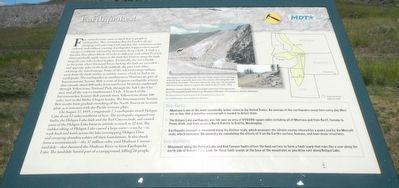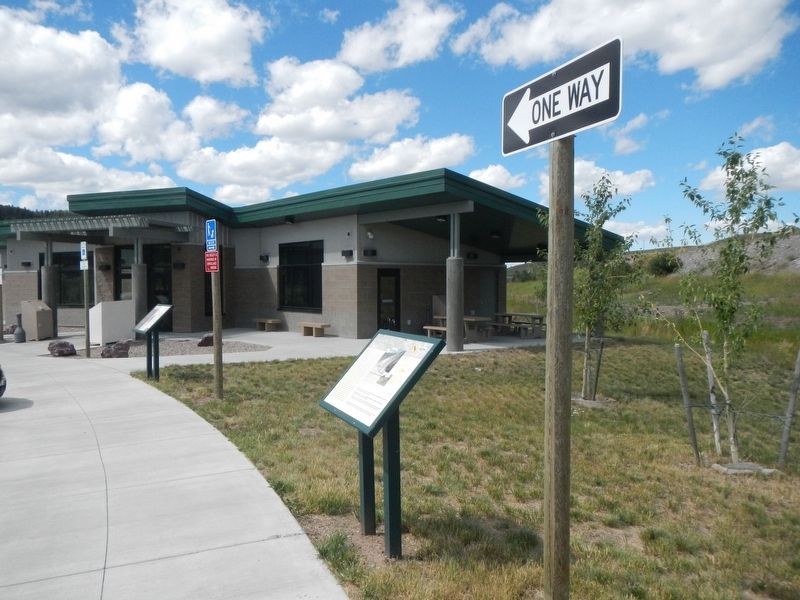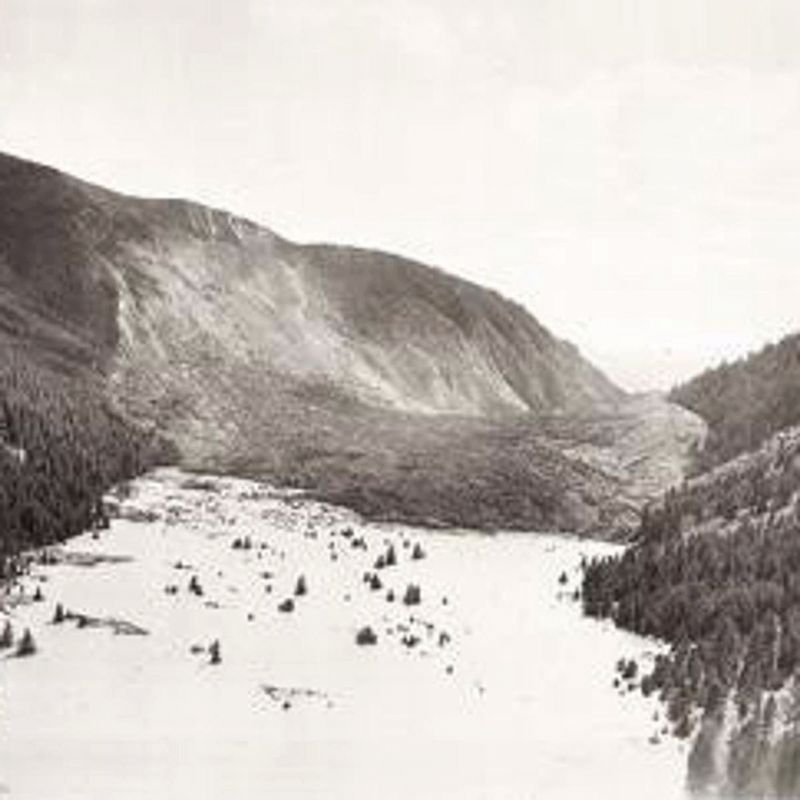Near Cameron in Madison County, Montana — The American West (Mountains)
Earthquakes!

Photographed By Barry Swackhamer, August 12, 2019
1. Earthquakes! Marker
Captions: (center) The Hebgen Lake Earthquake caused a large section of a mountain to break loose and slide down into the canyon, damming the river and killing 26 people. The arrow shows the direction the mountain slid. Inset image shows a scarp in the sand at Duck Creek, 1959.; Madison Canyon Quake Site. (Landslide with river in foreground.).; (upper right map) Intermountain Seismic Belt.
Few natural events cause as much fear in people as earthquakes. They remind us that the Earth is always changing and renewing itself and that this sometimes occurs violently and without warning. Earthquakes happen when stored energy is suddenly released by movement along a fault. A fault is a fracture that allows blocks of rocks to slide past each other. Tectonic forces gradually apply stress to the fault but friction along the fault keep the two sides locked in place. Eventually, the stress builds to the point where frictional forces locking the fault are exceeded and opposite sides of the fault suddenly slip past each other, releasing the stored energy. Some of this released energy radiates away from the fault surface as seismic waves, which we feel as an earthquake. The earthquakes in southwestern Montana are part of Intermountain Seismic Belt, a zone of frequent earthquake activity that extends about 800 miles from northwest Montana southward through Yellowstone National Park, through the Salt Lake City area, and all the way to southwestern Utah. A branch of the Intermountain Seismic Belt extends from Yellowstone about 300 miles west of the Idaho-Oregon border. The Intermountain Seismic Belt results from gradual stretching of the North American tectonic plate as it interacts with the Pacific tectonic plate.
On August 17, 1959, a magnitude 7.3 earthquake struck Hebgen Lake about 12 miles northeast of here. The earthquake ruptured two faults, the Hebgen Lake fault and the Red Canyon fault, and caused parts of the Hebgen Lake basin to subside as much as 22 feet. The sudden tilting of Hebgen Lake caused a large wave - a seiche - to wash back and forth across the lake overtopping Hebgen Dam and sweeping shoreline cabins off their foundations. It also shook loose a mountainside - the 37 million cubic yard Madison Canyon landslide - that dammed the Madison River to form Earthquake Lake. The landslide buried part of a campground, killing 26 people.
Geo-Facts:
• Montana is one of the more seismically active states in the United States. An average of five earthquakes occur every day. Most are to tiny that a sensitive seismograph is needed to detect them.
• The Hebgen Lake earthquake was felt over an area of 600,00 square miles including all of Montana and from Banff, Canada to Provo, Utah, and from western North Dakota to Seattle, Washington.
• Earthquake strength is measured using the Richter scale, which measures the seismic energy released by a quake and by the Mercalli scale, which measures the intensity by calculating the effects of it on the Earth's surface, humans, and man-made structures.
Geo-Activity:
• Movement along the Hebgen Lake and Red Canyon faults offer the land surface to form a fault scarp that runs like a scar along the north side of Hebgen Lake. Look for this fault scarps at the base of the mountains as you drive east along the Hebgen Lake.
Erected by Montana Department of Transportation.
Topics. This historical marker is listed in these topic lists: Disasters • Natural Features. A significant historical date for this entry is August 17, 1959.
Location. 44° 54.125′ N, 111° 35.594′ W. Marker is near Cameron, Montana, in Madison County. Marker is on Forest Road 209 near U.S. 287. Touch for map. Marker is in this post office area: Cameron MT 59720, United States of America. Touch for directions.
Other nearby markers. At least 4 other markers are within 11 miles of this marker, measured as the crow flies. A Tough Business (a few steps from this marker); Motoring Through Paradise: The Vigilante Trail (a few steps from this marker); Raynolds' Pass (approx. 8 miles away); The Seismic Shake that Shaped this Lake (approx. 10.3 miles away).
More about this marker. This marker is located at the Raynolds Pass Rest Area.
Also see . . . 1959 Hebgen Lake earthquake (aka 1959 Yellowstone earthquake). Wikipedia entry (Submitted on March 9, 2024, by Larry Gertner of New York, New York.)
Credits. This page was last revised on March 9, 2024. It was originally submitted on October 23, 2019, by Barry Swackhamer of Brentwood, California. This page has been viewed 165 times since then and 16 times this year. Photos: 1, 2, 3. submitted on October 23, 2019, by Barry Swackhamer of Brentwood, California.

